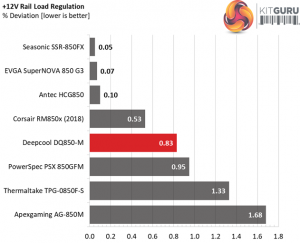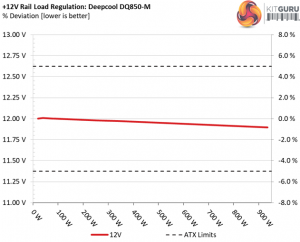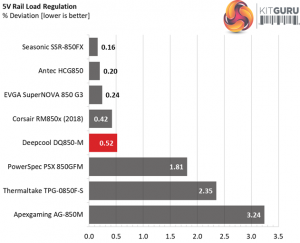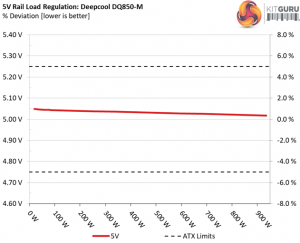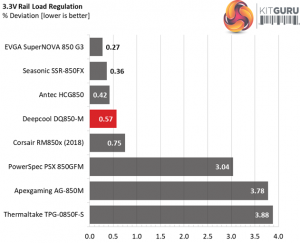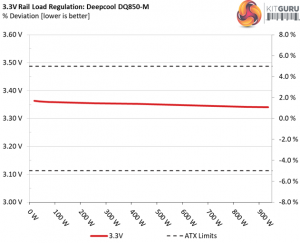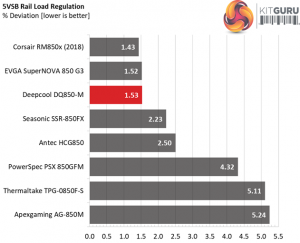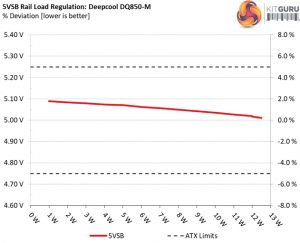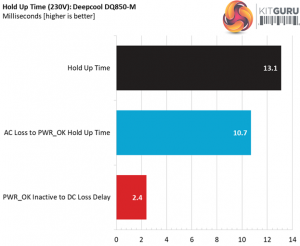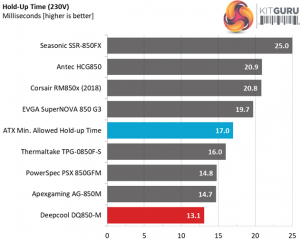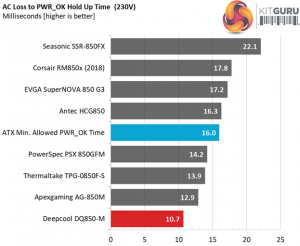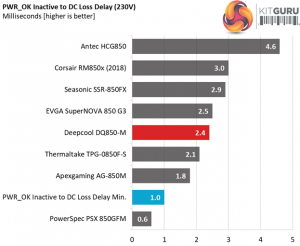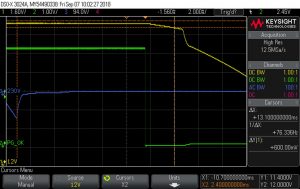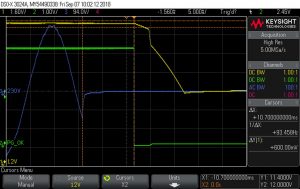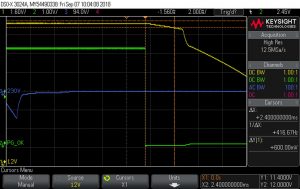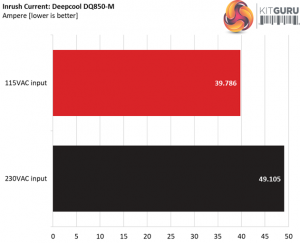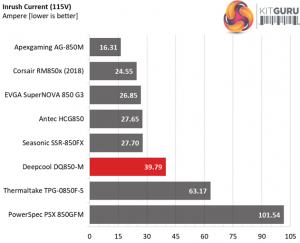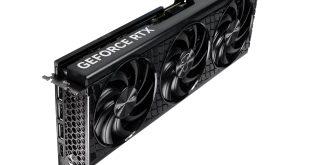To learn more about our PSU tests and methodology, please check out How We Test Power Supply Units.
Primary Rails And 5VSB Load Regulation
Load Regulation testing is detailed here.
Hold-Up Time
Our hold-up time tests are described in detail here.
The oscilloscope screenshots that we took during the hold-up time measurements:
The bulk cap's capacity is not high enough to offer a longer than 17ms hold-up time and this is a great shame. At least the power ok signal is accurate, however it is much lower than 16ms that the ATX spec requires.
Inrush Current
For details on our inrush current testing, please click here.
The registered inrush current with both 115V and 230V input is at normal levels for this wattage.
Load Regulation And Efficiency Measurements
The first set of tests reveals the stability of the voltage rails and the DQ850-M’s efficiency. The applied load equals (approximately) 10 to 110 percent of the power supplies maximum load in increments of 10 percentage points.
We conducted two additional tests.
During the first, we stressed the two minor rails (5V and 3.3V) with a high load, while the load at +12V was only 0.1A. This test reveals whether a power supply is compatible with Intel’s C6/C7 sleep states or not. In the second test, we determined the maximum load the +12V rail could handle with minimal load on the minor rails.
| Test # | 12V | 5V | 3.3V | 5VSB | DC/AC (Watts) | Efficiency | Fan Speed (RPM) | PSU Noise (dB[A]) | Temps (In/Out) | PF/AC Volts |
| 1 | 5.270A | 1.983A | 1.962A | 0.986A | 84.836 | 87.613% | 752 | 18.7 | 40.02°C | 0.966 |
| 12.001V | 5.044V | 3.359V | 5.070V | 96.830 | 43.67°C | 115.12V | ||||
| 2 | 11.546A | 2.976A | 2.946A | 1.185A | 169.339 | 90.793% | 757 | 18.7 | 40.27°C | 0.981 |
| 11.991V | 5.041V | 3.357V | 5.062V | 186.511 | 44.22°C | 115.11V | ||||
| 3 | 18.235A | 3.475A | 3.426A | 1.385A | 254.477 | 91.472% | 760 | 18.8 | 41.21°C | 0.983 |
| 11.981V | 5.038V | 3.355V | 5.056V | 278.201 | 45.47°C | 115.11V | ||||
| 4 | 24.930A | 3.973A | 3.936A | 1.585A | 339.675 | 91.416% | 755 | 18.7 | 41.75°C | 0.981 |
| 11.972V | 5.036V | 3.354V | 5.050V | 371.569 | 46.21°C | 115.11V | ||||
| 5 | 31.310A | 4.968A | 4.923A | 1.785A | 425.005 | 90.910% | 757 | 18.7 | 42.21°C | 0.980 |
| 11.961V | 5.033V | 3.352V | 5.042V | 467.500 | 47.29°C | 115.11V | ||||
| 6 | 37.630A | 5.963A | 5.911A | 1.986A | 509.517 | 89.698% | 757 | 18.7 | 42.77°C | 0.981 |
| 11.951V | 5.031V | 3.350V | 5.035V | 568.039 | 48.24°C | 115.11V | ||||
| 7 | 44.034A | 6.962A | 6.899A | 2.188A | 594.867 | 88.809% | 1200 | 28.2 | 43.83°C | 0.983 |
| 11.940V | 5.028V | 3.348V | 5.027V | 669.828 | 49.66°C | 115.23V | ||||
| 8 | 50.449A | 7.961A | 7.889A | 2.391A | 680.216 | 87.916% | 1655 | 37.1 | 44.34°C | 0.984 |
| 11.929V | 5.026V | 3.346V | 5.019V | 773.708 | 50.45°C | 115.14V | ||||
| 9 | 57.278A | 8.463A | 8.375A | 2.392A | 765.155 | 87.129% | 1743 | 40.9 | 45.20°C | 0.986 |
| 11.918V | 5.023V | 3.344V | 5.017V | 878.183 | 51.82°C | 115.29V | ||||
| 10 | 64.052A | 8.965A | 8.885A | 2.495A | 849.876 | 86.254% | 1743 | 40.9 | 45.38°C | 0.987 |
| 11.907V | 5.021V | 3.342V | 5.011V | 985.319 | 52.78°C | 115.15V | ||||
| 11 | 71.227A | 8.970A | 8.891A | 2.496A | 934.678 | 85.234% | 1743 | 40.9 | 46.58°C | 0.988 |
| 11.898V | 5.018V | 3.341V | 5.009V | 1096.597 | 54.30°C | 115.14V | ||||
| CL1 | 0.148A | 14.001A | 14.001A | 0.000A | 119.102 | 83.836% | 777 | 19.1 | 42.71°C | 0.977 |
| 11.986V | 5.034V | 3.346V | 5.080V | 142.065 | 47.83°C | 115.13V | ||||
| CL2 | 70.836A | 1.002A | 1.000A | 1.000A | 857.727 | 86.944% | 1750 | 40.9 | 45.30°C | 0.987 |
| 11.919V | 5.022V | 3.351V | 5.049V | 986.525 | 52.41°C | 115.21V |
There is no passive operation at light loads, however the fan profile is quite relaxed. It needs 80% of the unit's max rated load and over 44°C to push the fan high speeds and even in the worst case scenario the PSU's noise is at 41 dB(A).
The load regulation at +12V is tight enough, however it cannot compete against the performance of Seasonic's Focus platform. On the 5V and 3.3V rails the deviations are low as well and at 5VSB the load regulation is among the best in this category.
This platform easily meets the 80 PLUS Gold requirements with 20% and 50% load, even under high operating temperatures. It falls short with full load, however we apply almost 23°C more than what the 80 PLUS uses for its evaluations, and the higher the operating temperature the more the impact on a PSU's efficiency.
 KitGuru KitGuru.net – Tech News | Hardware News | Hardware Reviews | IOS | Mobile | Gaming | Graphics Cards
KitGuru KitGuru.net – Tech News | Hardware News | Hardware Reviews | IOS | Mobile | Gaming | Graphics Cards


